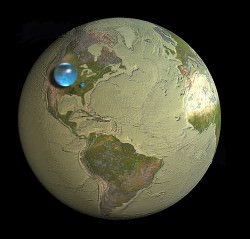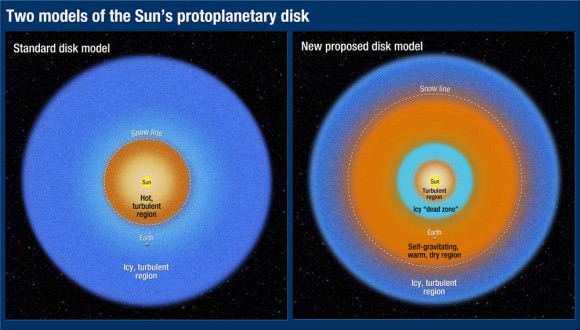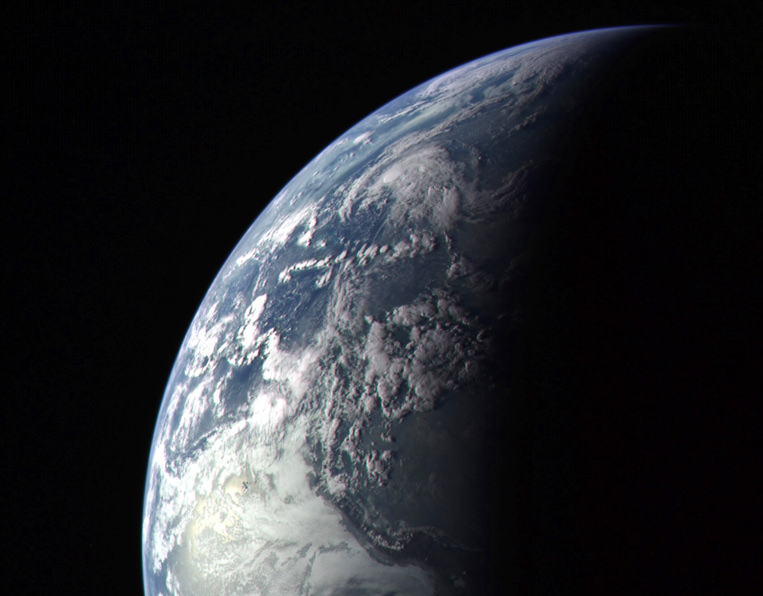Water, water everywhere… Coleridge’s shipbound ancient mariners were plagued by a lack of water while surrounded by a sea of the stuff, and while 70% of Earth’s surface is indeed covered by water (of which 96% is salt water, hence not a drop to drink) there’s really not all that much — not when compared to the entire mass of the planet. Less than 1% of Earth is water, which seems odd to scientists because, based on conventional models of how the Solar System formed, there should have been a lot more water available in Earth’s neck of the woods when it was coming together. So the question has been floating around: why is Earth so dry?
According to a new study from the Space Telescope Science Institute in Baltimore, MD, the answer may lie in the snow.
The snow line, to be exact. The region within a planetary system beyond which temperatures are cold enough for water ice to exist, the snow line in our solar system is currently located in the middle of the main asteroid belt, between the orbits of Mars and Jupiter. Based on conventional models of how the Solar System developed, this boundary used to be closer in to the Sun, 4.5 billion years ago. But if that were indeed the case, then Earth should have accumulated much more ice (and therefore water) as it was forming, becoming a true “water world” with a water mass up to 40 percent… instead of a mere one.
 As we can see today, that wasn’t the case.
As we can see today, that wasn’t the case.
“Planets such as Uranus and Neptune that formed beyond the snow line are composed of tens of percents of water. But Earth doesn’t have much water, and that has always been a puzzle.”
– Rebecca Martin, Space Telescope Science Institute
A study led astrophysicists Rebecca Martin and Mario Livio of the Space Telescope Science Institute took another look at how the snow line in our solar system must have evolved, and found that, in their models, Earth was never inside the line. Instead it stayed within a warmer, drier region inside of the snow line, and away from the ice.
“Unlike the standard accretion-disk model, the snow line in our analysis never migrates inside Earth’s orbit,” Livio said. “Instead, it remains farther from the Sun than the orbit of Earth, which explains why our Earth is a dry planet. In fact, our model predicts that the other innermost planets, Mercury, Venus, and Mars, are also relatively dry. ”
Read: Rethinking the Source of Earth’s Water
The standard model states that in the early days of a protoplanetary disk’s formation ionized material within it gradually falls toward the star, drawing the icy, turbulent snow line region inward. But this model depends upon the energy of an extremely hot star fully ionizing the disk — energy that a young star, like our Sun was, just didn’t have.
“We said, wait a second, disks around young stars are not fully ionized,” Livio said. “They’re not standard disks because there just isn’t enough heat and radiation to ionize the disk.”

“Astrophysicists have known for quite a while that disks around young stellar objects are NOT standard accretion disks (namely, ones that are ionized and turbulent throughout),” added Dr. Livio in an email to Universe Today. “Disk models with dead zones have been constructed by many people for many years. For some reason, however, calculations of the evolution of the snow line largely continued to use the standard disk models.”
Without fully ionized disk, the material is not drawn inward. Instead it orbits the star, condensing gas and dust into a “dead zone” that blocks outlying material from coming any closer. Gravity compresses the dead zone material, which heats up and dries out any ices that exist immediately outside of it. Based on the team’s research it was in this dry region that Earth formed.
The rest, as they say, is water under the bridge.
The team’s results have been accepted for publication in the journal Monthly Notices of the Royal Astronomical Society.
Read the release on the Hubble news site here, and see the full paper here.
Lead image: Earth as seen by MESSENGER spacecraft before it left for Mercury in 2004. NASA/Johns Hopkins University Applied Physics Laboratory/Carnegie Institution of Washington. Disk model image: NASA, ESA, and A. Feild (STScI). Earth water volume image: Howard Perlman, USGS; globe illustration by Jack Cook, Woods Hole Oceanographic Institution (©); Adam Nieman.


Can’t you just be happy with what we have? Want-want-want.
More more more…wa-wa-wa…
“Resistance is futile. You will be ice-simulated.”
– Subspace broadcast from a Borg not-so-nice cube.-
I’m sure Kevin Costner is ready for this scenario…
Don’t I feel both stupid and gratified now. When I commented on Earth’s water lately I forgot that the ice line migrates in the disk in the old models. On the other hand it predicts a generic model for terrestrial water content and Earth-Moon and Mars initial mantle hydrogen content. Which is good for habitability as we know it, having continents amid all the water.
In earlier models the relative dryness of Earth has among other mechanisms been blamed on the Earth-Moon impact event, liberating hydrogen to vanish in space before the Moon reassembled. Clearly there was never much hydrogen to loose in the first place, and the current water can as well have been replaced as the crust reformed after the impact.
I wonder if not this house-of-cards effect now will make predicting the near identical oxygen and titanium isotope ratios of Earth and Moon easier now? For example, naively a homogenization of material at the impact event wouldn’t mean so much finetuning for the retaining of water.
40%, we would have been swimming in a ocean at this moment, instead of typing on a keyboard.
How deep would that make the ocean? I’m assuming even Mt. Everest would be covered.
If with 1% water 70% of the earth’s surface is under water you can bet that with 40% water no dry land would, could exist, however high a mountain would be.
If you think about it, how would whe have evolved , as marine mammals ?
We probably wouldent be, by far, top of the food chain.
Marine mammals? Not likely, marine mammals only exist because land bound mammals evolved back to an aquatic life style. The only reason we are top of the food chain is because of our superior intellect. So… a brainy fish?
Or cephalopods, there are free swimming such. Though squids rule here, and the large ones don’t seem too bad on the brainy part – complex food seeking behaviors.
Note that fish are oviviparous (say, some sharks) and they have found reptiles that have a mammal-like uterus. (A skink presented this spring is spot on, with the same blood near coupling between mother and fetus.)
Large fishes are effectively endothermic poikilotherms with a similar body temperature as mammals @ ~ 20 degC (say, some sharks).
The problem with water worlds re ETI is that advanced technology would be ionics instead of electronics. Even the electron transport chain in our cells is ion based and so slower.
If they could manipulate molecules, sure, photosynthesis molecules are fast electron manipulators. Hard but perhaps not impossible to rig fast logic.
It is what it is. Does anyone else see more water on any other planet. How can we say there should be more. Ofcourse, maybe there was more water. Mabey the whole earth was covered miles and miles deep in ken Costners waterworld. Then when the moon was formed during an impact it was all mostly blown away. And, when the moons mass lifted off our hevenly body during the impact, some of it couldn’t reach escape velocity. Leaving behind what we know as the first continent pangea surrounded by what water was left over, on an irregularly shaped orb destined to crack apart creating the continents we know and love today.
“Could time in the form of some type of evaporation by some sort of solar wind have changed the percieved line.”
That was the general hypothesis that they new one replaces, with better consistency with other theory and predictive ability (predicts the water content of 5 bodies consistent with observation).
“Mars had water didn’t it. … Then when the moon was formed during an impact the water was all mostly blown away.”
The Moon and now recently Mars has been reevaluated to have the initial same amount of water in the mantle.
That is why this result IMHO is both timely and interesting.
“And, when the moons mass lifted off our hevenly body during the violent impact, some of it couldn’t reach escape velocity. Leaving behind what we know as the first and only continent, called pangea, surrounded by what water was left over, on an irregularly shaped orb, perspectively, destined to crack apart creating the continents we know and love today.”
The Earth-Moon impactor may have contributed to some early mantle differentiation (differences in composition) that has survived in places. [“182W Evidence for Long-Term Preservation of Early Mantle Differentiation Products”, Touboul et al, Science 2012.] However it is impossible to tell yet what mechanisms contributed.
[My personal feeling is that instead the constraints tell us there was a thorough mixing between mantle and impactor, see my earlier comment. It would predict much which is observed.]
More importantly, it is believed the impact event stripped the first crust which had to reform.
In any case the crust that made and survived in plate tectonics are much younger than the impact, which happened ~ 4.5 – 4.3 Ga bp (billion years before present). The earliest established crust is ~ 3.8 Ga bp, and zircons that can, arguably, hint at a plate tectonic equivalent rework are ~ 4 Ga bp.
Pangaea is the latest single supercontinent @ ~ 0.3 Ga bp. It is obviously today replaced with many continents.
It is highly controversial re evidence but before Pangaea, there were likely other single supercontinents: Rodinia @ ~ 1 Ga bp, before that Columbia @ ~ 1.7 Ga bp, Kenorland @ ~ 2.5 Ga bp, Valbaara @ 3 Ga bp. (See also here.) Certainly the evidence shows that there were continents before Pangaea.
If until now was considered that the Earth formed inside the protoplanetary disk snowline, why there was all that discussion about “from where earth water came from?”
Until this article everyone seemed to believe that earth accreted dry, and water came from comets and meteorites. Both explanations are inconsistent with the chemical and isotopic composition of earth oceans and upper mantle (and crust).
Only very few people proposed wet accretion, and that was due to adsorbtion of water vapor molecules on olivine dust grains.
Why nobody considered the possibility that earth’s water entered earth as ice during accretion?